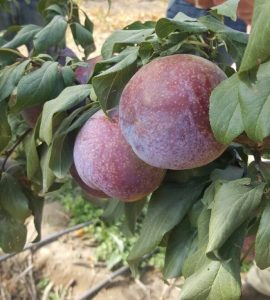New sweet plum variety developed in Chile

Sweet Pekeetah is aimed at exports to the Chinese market while researchers also have commercial ambitions to grow the new cultivar in North America and Europe.
For decades Chile has been the counterseasonal summer fruit bowl for overseas markets during the Northern Hemisphere winter, attracting flavorsome internationally-developed varieties through licenses to capitalize on what can often be lucrative market windows.
That trend is unlikely to stop soon, but within grower circles there has also long been a push for homegrown cultivars that better suit local conditions and still meet export market demands.
One of the best examples of this has been Iniagrape-one, a rising star that is now the 10th ranked new table grape variety for Chile in terms of exports with 1,704 metric tons (MT) shipped in the 2016-17 season, while plant material has also sent to the U.S., Europe, South Africa, Australia and India for production trials.
Agronomists at the Universidad de Chile will be hoping the Sweet Pekeetah plum can emulate that success. At Fresh Fruit Portal we caught up with research leader Rodrigo Infante to find out more about this cultivar that has taken 10 years to develop.
"It's quite paradoxical what happens with plums in Chile. It's easier to get budgets for research in peaches and nectarines, but from an export point of view plums are much more important for the country," he said.
He said the study began in response to what were seen as flavor deficiencies in available varieties, frequently too tart and lacking in sensory qualities.
"In our program our basic requirements were good taste and a prolonged harvest," Infante said.
The scientist said both these demands were met in Sweet Pekeetah, a fruit characterized by its high sugar content of between 20-21° Brix and a slow ripening process on the plant and at post-harvest.
Infante emphasized the post-harvest benefits by highlighting the variety could maintain its sensory qualities for up to 70 days after picking - a key advantage given Chile's distance from its export markets.
The fruit's skin is dark and it weighs 150 grams (5.2 ounces) on average.
"One of its characteristics is that it flowers very late, between mid- and late-September. Although it will be saved from weather problems related to low temperatures, the right pollinators need to be found. That is a productive challenge that has to be taken on," Infante said.
While Sweet Pekeetah is not yet for sale it is a protected variety in Chile, and is expected to be registered in foreign jurisdictions soon.
"We are patenting it in the United States because we are also thinking of developing it commercially in North America and Europe," he said.
In terms of Chilean plantings, the plum is still limited to experimental plots administered by the university in partnership with growers.
"We have evaluation agreements with eight companies that are fruit growers and exporters. For the moment we are evaluating the whole fruit growing-region of Metropolitana to the VII (Maule) region. 
"The first plants will be sold this year or at the start of the next."
Infante said Sweet Pekeetah sales would be focused solely on exports, but of course some fruit will trickle into the domestic market if it does not have the attributes required to arrive in far-flung markets in the best condition.
"This is an export fruit we hope that it will be well-received in the Chinese market," Infante said
"We predict that because the product will have its sensory qualities intact and a taste that will be very recognized and favored by Chinese consumers. Because of the characteristics it has, we are very sure that it's a variety the Asian country will like."
Photo: Faculty of Agronomic Sciences, Universidad de Chile.















































